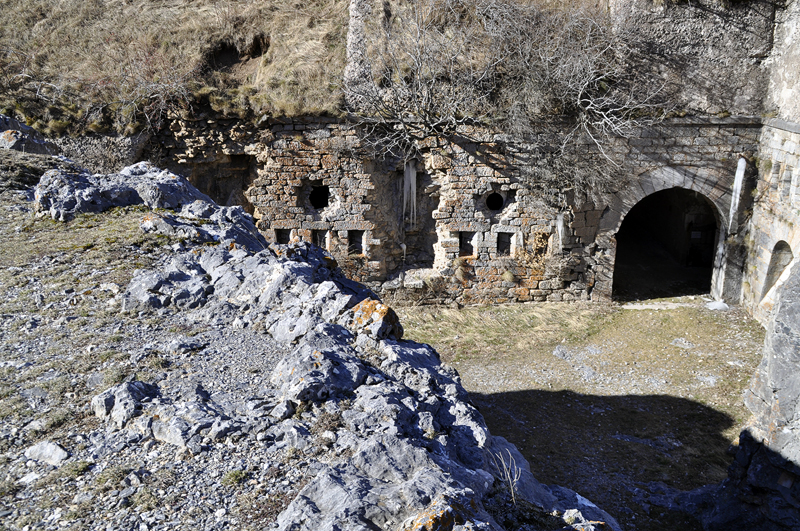Canfranc. Coll de Ladrones Fort
The Coll de Ladrones (Robber’s Pass) Fort is one of the most unusual structures in the Canfranc valley, also known as the “fortified valley” due to its numerous defensive structures from different historical periods.
An original fortress was built here between 1751 and 1758 by Pascual de Navas, making the most of the strategic position at this natural vantage point. However, the poor state of the building soon led to its demise. In 1777, it was abandoned but was reoccupied temporarily during the War of the Pyrenees (1793-1795).
At the end of the 19th century, the idea of building a fort to protect the valley was once again considered. In this instance, the project formed part of the demands made by the Spanish War Ministry in exchange for permitting the construction of the Oloron-Canfranc international railway line. The War of Independence was still fresh in the collective memory and the fear of renewed French incursions spurred the construction of defensive structures which left their mark throughout the valley. The new “Coll de Ladrones” fort was built as a replica of the French fort of Portalet, on the other side of the frontier.
Work began in 1888 and was not completed until the beginning of the 20th century. The original building was almost completely demolished and even the location itself was modified by lowering the summit of the mountain prior to construction. An entrance and a trench were carved out of the rock on the east side. The subterranean casemates for artillery pointed in a northwest to northeast direction. From the road, it is possible to see the casemated gallery carved into the rock, descending to another battery.
The fort soon became redundant as a result of the technological innovations applied to warfare and soon after its first use it became military archeology. The famous soldier and geographer, Rafael Torres Campo, had already predicted the fate of this structure in 1889 – “it will be a beautiful showpiece with no more use than as an entertainment to curious visitors and a witness to futile pride”. In 1961 it was definitively shut down and in 1990 it came into private ownership as a result of a public auction.
An original fortress was built here between 1751 and 1758 by Pascual de Navas, making the most of the strategic position at this natural vantage point. However, the poor state of the building soon led to its demise. In 1777, it was abandoned but was reoccupied temporarily during the War of the Pyrenees (1793-1795).
At the end of the 19th century, the idea of building a fort to protect the valley was once again considered. In this instance, the project formed part of the demands made by the Spanish War Ministry in exchange for permitting the construction of the Oloron-Canfranc international railway line. The War of Independence was still fresh in the collective memory and the fear of renewed French incursions spurred the construction of defensive structures which left their mark throughout the valley. The new “Coll de Ladrones” fort was built as a replica of the French fort of Portalet, on the other side of the frontier.
Work began in 1888 and was not completed until the beginning of the 20th century. The original building was almost completely demolished and even the location itself was modified by lowering the summit of the mountain prior to construction. An entrance and a trench were carved out of the rock on the east side. The subterranean casemates for artillery pointed in a northwest to northeast direction. From the road, it is possible to see the casemated gallery carved into the rock, descending to another battery.
The fort soon became redundant as a result of the technological innovations applied to warfare and soon after its first use it became military archeology. The famous soldier and geographer, Rafael Torres Campo, had already predicted the fate of this structure in 1889 – “it will be a beautiful showpiece with no more use than as an entertainment to curious visitors and a witness to futile pride”. In 1961 it was definitively shut down and in 1990 it came into private ownership as a result of a public auction.
Also consult...
¤ Monuments
¤ Nature
¤ Villages
¤ Sport
¤ Tourist Offices
¤ Museums and Interpretation Centres
Guided tours 360°
Ciudadela de Jaca
[Español] · [Inglés]
Monasterio de San Juan de la Peña
[Español] · [Inglés]
Fort du Portalet
[Español] · [Francés]
follow us in...




 Comarca de La Jacetania
Comarca de La Jacetania
C/ Ferrocarril s/n 22700
JACA (Huesca)
T. (+34) 974 356 980
F. (+34) 974 355 241
:: Oficina de Turismo de JACA: 974 360 098
:: Oficina de Turismo de CANFRANC:
974 373 141
Site Map









